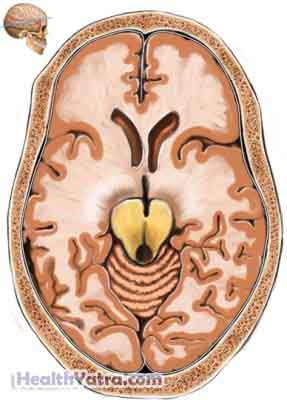تعريف
Parkinson’s disease (PD) is a movement disorder. The symptoms get worse over time and can include:
- Muscle rigidity
- Tremor at rest
- Slowing down of movements (bradykinesia)
- Difficulty moving and gait instability

أسباب
PD is caused by a loss of certain nerve cells in the brain. The loss of these cells causes a decrease in the amount of a brain chemical called dopamine. Low dopamine levels cause PD symptoms.
The brain cells may be lost because of genetic defects, the environment, or some combination of the two. A small amount of people with PD have an early-onset form. This type is caused by an inherited gene defect.
Secondary PD has similar symptoms but is caused by several factors such as:
- Antipsychotic drugs, such as haloperidol (Haldol), fluphenazine (Prolixin), trifluoperazine (Stelazine), and chlorpromazine (Thorazine)
- Antinausea/gastric motility medications such as prochlorperazine and metoclopramide
- Cardiovascular drugs, such as some calcium channel blockers and antiarrhythmic drugs
- Valproic acid (a medication used for seizures, migraines, and bipolar disorder)
- Carbon monoxide poisoning
- Manganese poisoning
- استسقاء الرأس
- أورام الدماغ
- سكتة دماغية
- التهاب الدماغ
- التهاب السحايا
- IV drug abuse contaminated by MPTP (a type of neurotoxin)
- Reserpine (medicine to treat schizophrenia and high blood pressure)
- Insecticide exposure
- صدمة
- الإيدز
عوامل الخطر
Factors that increase the chance of PD include:
- Age: 50 years or older
- History of polio
- Gender: men (slightly more likely to develop PD)
- Family members with PD
- Nonsmokers
- Exposure to toxins, drugs, or conditions listed above
- عالي الدهون
- Melanoma skin سرطان
الأعراض
Symptoms of PD begin mildly. They will worsen over time.
تشمل الأعراض ما يلي:
- “Pill-rolling” tremor in the hands
- Tremors are present at rest, improve with movement, and are absent during sleep
- Stiffness and rigidity of muscles, usually beginning on one side of the body
- Difficulty and shuffling when walking
- Short steps
- Slowness of purposeful movements
- Trouble performing usual tasks, due to shaking in hands and slowness of movement
- Trouble speaking (often speaking with a low volume)
- Flat, monotonous voice
- تأتأة
- Shaky, spidery, or small handwriting
- ضعف التوازن
- Difficulty with rising from a sitting position
- “Freezing”
- قلق
- Seborrhea (a skin problem that causes a red rash and white scales)
- فقدان الرائحة
- Urinary symptoms (frequency and urgency)
- Bowel movement symptoms (straining, constipation)
- Tendency to fall
- Stooped posture
- Increasingly mask-like face, with little variation in expression
- Trouble chewing and swallowing
- Drooling and excessive salivation
- اكتئاب
- الخَرَف
- الهلوسة
- Difficulty thinking, problems with memory
- Decreased sense of smell
- Sleep problems such as REM-behavior disorder
التشخيص
The doctor will ask about your symptoms and medical history, and perform a physical exam. There are no tests to definitively diagnose PD. The doctor will ask many questions. This will help to rule out other causes of your symptoms.
Tests to rule out other conditions may include:
- تحاليل الدم
- اختبارات البول
- التصوير المقطعي المحوسب - نوع من الأشعة السينية يستخدم جهاز كمبيوتر لعمل صور لهياكل داخل الرأس
- التصوير بالرنين المغناطيسي – اختبار يستخدم الموجات المغناطيسية لالتقاط صور للهياكل داخل الرأس
- PET scan—a scan that makes images that show the amount of activity in the brain. A special kind of PET scan called a DAT scan may be used in the evaluation of PD.
العلاج
Currently, there are no treatments to cure PD. There are also no proven treatments to slow or stop its progression. Some medications may help to improve symptoms. Over time, the side effects of the medication may become troublesome. The medications may also lose their effectiveness.
الأدوية
Examples of medicines include:
- Levodopa/carbidopa (Sinemet)
- Amantadine (Symmetrel)
- Anticholinergics: benztropine (Cogentin) and biperiden (Akineton)
- Monoamine oxidase inhibitors, such as selegiline (Eldepryl)
- Dopamine agonists: bromocriptine (Parlodel), pramipexole (Mirapex), Cabergoline (Dostinex), Rotigotine (Neupro), apomorphine (Apokyn), and ropinirole (Requip)
- COMT inhibitors: entacapone (Comtan) and tolcapone (Tasmar)
Depression or hallucinations may also occur with PD and its treatment. Medicines may be prescribed to attempt to treat these conditions. The drugs may include:
- Selective serotonin reuptake inhibitors (SSRIs)
- Tricyclic antidepressant (such as, nortriptyline)
- Antipsychotic medicine (such as, clozapine)
Hip fractures are common in those with PD. Bisphosphonates are medications that may help reduce this risk.
Constipation, drooling, and lightheadedness when standing are common and may improve with medications or other treatments.
جراحة
Different brain operations are available, and many more are being researched including:
- Deep brain stimulation (DBS)—implanting a device to stimulate certain parts of the brain; can decrease tremor and rigidity
- Thalamotomy and pallidotomy—destroying certain areas of the brain to improve tremor when medication does not work (not as common as deep brain stimulation)
- Nerve-cell transplants (research only)—to increase amount of dopamine made in the brain
علاج بدني
Therapy can improve muscle tone, strength, and balance. It will include exercises and stretches.
Psychological Support
Consider joining a support group with other people with PD. It will help to learn how others are learning to live with the challenges of PD.
If you are diagnosed with PD, follow your doctor’s instructions.
الوقاية
There are no guidelines for preventing PD.
